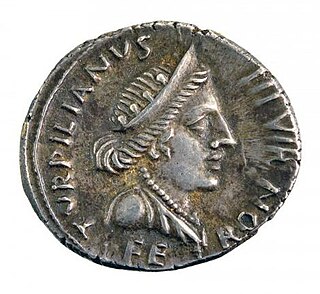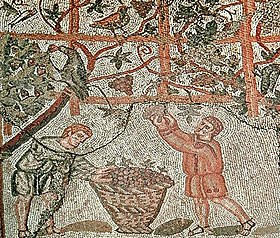
Venus is a Roman goddess whose functions encompass love, beauty, desire, sex, fertility, prosperity, and victory. In Roman mythology, she was the ancestor of the Roman people through her son, Aeneas, who survived the fall of Troy and fled to Italy. Julius Caesar claimed her as his ancestor. Venus was central to many religious festivals, and was revered in Roman religion under numerous cult titles.

Jupiter, also known as Jove, is the god of the sky and thunder, and king of the gods in ancient Roman religion and mythology. Jupiter was the chief deity of Roman state religion throughout the Republican and Imperial eras, until Christianity became the dominant religion of the Empire. In Roman mythology, he negotiates with Numa Pompilius, the second king of Rome, to establish principles of Roman religion such as offering, or sacrifice.

In ancient Roman religion, Ceres was a goddess of agriculture, grain crops, fertility and motherly relationships. She was originally the central deity in Rome's so-called plebeian or Aventine Triad, then was paired with her daughter Proserpina in what Romans described as "the Greek rites of Ceres". Her seven-day April festival of Cerealia included the popular Ludi Ceriales. She was also honoured in the May lustration (lustratio) of the fields at the Ambarvalia festival: at harvest-time: and during Roman marriages and funeral rites. She is usually depicted as a mature woman.

In ancient Roman religion and mythology, Liber, also known as Liber Pater, was a god of viticulture and wine, male fertility and freedom. He was a patron deity of Rome's plebeians and was part of their Aventine Triad. His festival of Liberalia became associated with free speech and the rights attached to coming of age. His cult and functions were increasingly associated with Romanised forms of the Greek Dionysus/Bacchus, whose mythology he came to share.
Bona Dea was a goddess in ancient Roman religion. She was associated with chastity and fertility among married Roman women, healing, and the protection of the state and people of Rome. According to Roman literary sources, she was brought from Magna Graecia at some time during the early or middle Republic, and was given her own state cult on the Aventine Hill.
Libitina, also Libentina or Lubentina, is an ancient Roman goddess of funerals and burial. Her name was used as a metonymy for death, and undertakers were known as libitinarii. Libitina was associated with Venus, and the name appears in some authors as an epithet of Venus.
Festivals in ancient Rome were a very important part in Roman religious life during both the Republican and Imperial eras, and one of the primary features of the Roman calendar. Feriae were either public (publicae) or private (privatae). State holidays were celebrated by the Roman people and received public funding. Games (ludi), such as the Ludi Apollinares, were not technically feriae, but the days on which they were celebrated were dies festi, holidays in the modern sense of days off work. Although feriae were paid for by the state, ludi were often funded by wealthy individuals. Feriae privatae were holidays celebrated in honor of private individuals or by families. This article deals only with public holidays, including rites celebrated by the state priests of Rome at temples, as well as celebrations by neighborhoods, families, and friends held simultaneously throughout Rome.
The Robigalia was a festival in ancient Roman religion held April 25, named for the god Robigus. Its main ritual was a dog sacrifice to protect grain fields from disease. Games (ludi) in the form of "major and minor" races were held. The Robigalia was one of several agricultural festivals in April to celebrate and vitalize the growing season, but the darker sacrificial elements of these occasions are also fraught with anxiety about crop failure and the dependence on divine favor to avert it.

The Floralia was a festival of ancient Roman religion in honor of the goddess Flora, held on 27 April during the Republican era, or 28 April in the Julian calendar. The festival included Ludi Florae, the "Games of Flora", which lasted for six days under the empire.

In Roman religion, Terminus was the god who protected boundary markers; his name was the Latin word for such a marker. Sacrifices were performed to sanctify each boundary stone, and landowners celebrated a festival called the "Terminalia" in Terminus' honor each year on February 23. The Temple of Jupiter Optimus Maximus on the Capitoline Hill was thought to have been built over a shrine to Terminus, and he was occasionally identified as an aspect of Jupiter under the name "Jupiter Terminalis".

In ancient Roman religion and mythology, Tellus Mater or Terra Mater is the personification of the Earth. Although Tellus and Terra are hardly distinguishable during the Imperial era, Tellus was the name of the original earth goddess in the religious practices of the Republic or earlier. The scholar Varro (1st century BC) lists Tellus as one of the di selecti, the twenty principal gods of Rome, and one of the twelve agricultural deities. She is regularly associated with Ceres in rituals pertaining to the earth and agricultural fertility.

In Etruscan and Sabine religion, Feronia was a goddess associated with wildlife, fertility, health, and abundance, also venerated by the Faliscans and later adopted into ancient Roman religion. As the goddess who granted freedom to slaves or civil rights to the most humble part of society, she was especially honored among plebeians and freedmen. Her festival, the Feroniae, was November 13 during the Ludi Plebeii, in conjunction with Fortuna Primigenia; both were goddesses of Praeneste.

Vulcan is the god of fire including the fire of volcanoes, deserts, metalworking and the forge in ancient Roman religion and myth. He is often depicted with a blacksmith's hammer. The Vulcanalia was the annual festival held August 23 in his honor. His Greek counterpart is Hephaestus, the god of fire and smithery. In Etruscan religion, he is identified with Sethlans.

Ancient Rome played a pivotal role in the history of wine. The earliest influences on the viticulture of the Italian Peninsula can be traced to ancient Greeks and the Etruscans. The rise of the Roman Empire saw both technological advances in and burgeoning awareness of winemaking, which spread to all parts of the empire. Rome's influence has had a profound effect on the histories of today's major winemaking regions in France, Germany, Italy, Portugal and Spain.
In ancient Roman religion, the Fordicidia was a festival of fertility, held on the Ides of April, that pertained to farming and animal husbandry. It involved the sacrifice of a pregnant cow to Tellus, the ancient Roman goddess of the Earth, in proximity to the festival of Ceres (Cerealia) on April 19.
The Aventine Triad is a modern term for the joint cult of the Roman deities Ceres, Liber and Libera. The cult was established c. 493 BC within a sacred district (templum) on or near the Aventine Hill, traditionally associated with the Roman plebs. Later accounts describe the temple building and rites as "Greek" in style. Some modern historians describe the Aventine Triad as a plebeian parallel and self-conscious antithesis to the Archaic Triad of Jupiter, Mars and Quirinus and the later Capitoline Triad of Jupiter, Minerva and Juno. The Aventine Triad, temple and associated ludi served as a focus of plebeian identity, sometimes in opposition to Rome's original ruling elite, the patricians.

The history of the wine press and of pressing is nearly as old as the history of wine itself with the remains of wine presses providing some of the longest-serving evidence of organised viticulture and winemaking in the ancient world. The earliest wine press was probably the human foot or hand, crushing and squeezing grapes into a bag or container where the contents would ferment.
Venus Obsequens was the first Venus for whom a shrine (aedes) was built in ancient Rome. Little is known of her cult beyond the circumstances of her temple founding and a likely connection to the Vinalia Rustica, an August wine festival.












